Python中的count()函数是Python的一个内置字符串操作函数,其作用是统计一个字符串中某个字符或子字符串出现的次数。
Python中的count()函数接受一个字符或子字符串作为参数,并返回该字符或子字符串在原字符串指定范围内出现的次数。
count()函数的语法格式如下:
string_name.count(string, start_index, end_index)
该函数有3个参数,其含义如下:
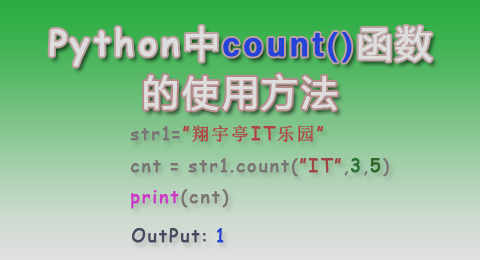
下面使用几个例子来介绍该函数的具体使用方法:
例子1:
str1 = "武林网VEVB"
cnt = str1.count("IT")
print(cnt)
输出:1
即 str1 字符串中有 1 个“IT”子字符串。
例子2:
str1 = "武林网VEVB"
cnt = str1.count("Python")
print(cnt)
输出:0
即str1字符串中有 0 个子字符串“Python”.
例子3:
str1 = "武林网VEVB"
cnt = str1.count("it")
print(cnt)
输出:0
从这个例子中可以看出,Python中字符串处理函数count()对字符串是区分大小写的。
以上3个例子在Python 3.8.2 IDLE中的运行情况如下图所示:
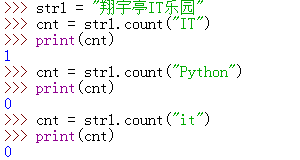
例子4:
str1 = "武林网VEVB"
str2 = "IT"
cnt = str1.count(str2, 3)
print(cnt)
输出:1
即从str1位置3开始搜索(也就是从字符I开始搜索),能找到1个子字符串。
例子5:
str1 = "武林网VEVB"
str2 = "IT"
cnt = str1.count(str2, 4)
print(cnt)
输出:0
从索引位置4开始搜索(即字符“T”开始搜索),没有找到匹配的子字符串。
以上两例在Python 3.8.2 IDLE中执行的情况如下图所示:
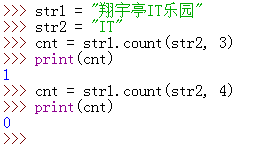
例子6:
str1 = "武林网VEVB"
str2 = "IT"
cnt = str1.count(str2, 3, 5)
print(cnt)
输出:1
从索引位置3开始搜索,搜索到索引位置5,可以找到1个子字符串。
例子7:
str1 = "武林网VEVB"
cnt = str1.count("IT", 3, 4)
print(cnt)
输出:0
从索引位置3开始(字符“I”),搜索到索引位置4(即字符“T”),结果为0.
要注意的是:end_index是搜索停止位置的索引,所以搜索范围不会包括end_index处的字符。
以上两例在Python3.8.2 IDLE中的执行情况如下图所示:
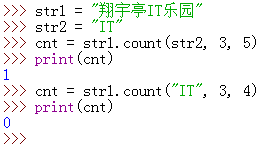
后面两个参数,即start_index和end_index可以取负值,取负值时是从后往前数所在的索引位置,如-1,这里指的是从最后一个字符位置,-2是从后面第2个字符位置,以此类推。
(1)start_index为负的情况
例子8:
str1 = "武林网VEVB"
cnt = str1.count("IT", -4)
print(cnt)
输出:1
这里,start_index的取值为-4,即从后往前数第4个字符作为搜索的起始位置(是字符“I”),可以找到1个子字符串。
例子9:
str1 = "武林网VEVB"
cnt = str1.count("IT",-10)
print(cnt)
输出:1
这里,start_index参数的值为-10,但str1只有7个字符,这时可以认为Python处理时是从0开始的。
以上两例在Python 3.8.2 IDLE中执行的情况如下图所示:
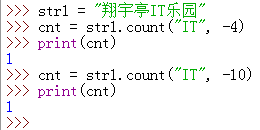
(2)end_index参数为负的情况
例子10:
str1 = "武林网VEVB"
cnt = str1.count("IT", 3, -2)
print(cnt)
输出:1
此例是从索引位置3(即字符“I”)开始,搜索停止索引位置-2(即字符“乐”)。
例子11:
str1 = "武林网VEVB"
cnt = str1.count("IT", 3, -3)
print(cnt)
输出:0
从索引位置 3(即字符“I”)开始,搜索停止索引位置 -3 (即字符“T”),没有找到子字符串。
例子12:
str1 = "武林网VEVB"
cnt = str1.count("IT", -4, -2)
print(cnt)
输出:1
从后往前数第4个字符“I”开始,搜索停止的位置是从后往前数第2个字符“乐”,找到1个子字符串。
以上3例在Python3.8.2 IDLE中执行的情况如下图所示:
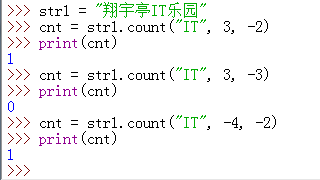
下面这个例子中使用到了casefold()函数,把字符串中的字母都变为小写,所以两次统计的结果是不同的。
str_doc = "I love You.I love everything.Love is the eternal truth in the world."
search_word = "love"
word_cnt1 = str_doc.count(search_word)
word_cnt2 = str_doc.casefold().count(search_word)
print(word_cnt1)
print(word_cnt2)
输出:
2
3

新闻热点
疑难解答